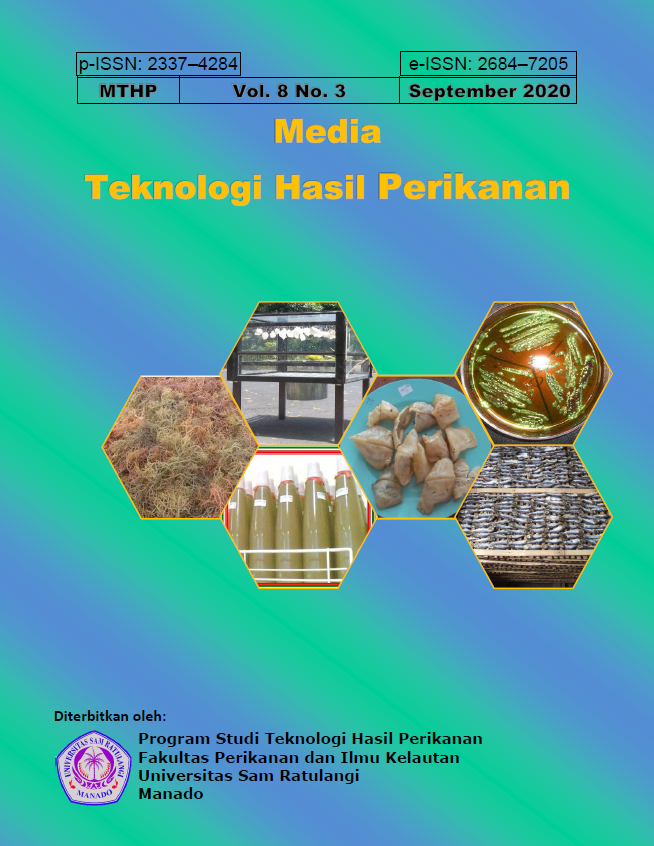Substitusi Tepung Buah Mangrove Bruguiera gymnorrhiza Pada Camilan Stick
DOI:
https://doi.org/10.35800/mthp.8.3.2020.29434Keywords:
Bruguiera gymorrhiza, Yield, Moisture Content, Total Plate Rate, pH, OrganolepticAbstract
Bruguiera gymnorrhiza mangrove plant is one type of mangrove that can be used as a new food source, because this species contains high carbohydrates. The purpose of this study was to treat B. gymorrhiza mangroves into flour and processed into sticks. The study was divided into two stages, first treating B. gymorrhiza mangroves into flour including boiling, cutting, drying and grinding, secondly managing B. gymorrhiza mangrove flour into sticks including mixing ingredients, mixing dough, molding dough and frying. The first research was obtained yield of 27.96%, moisture content greater than SNI flour which was 14%, Total Plate Figures of 2.8x103 colonies/gram, and pH 5.0. The second study carried out organoleptic tests with two mangrove flour treatments namely 50% B. gymorrhiza +50% Wheat flour and 25% B. gymorrhiza +75% Wheat flour, from 41 semi-trained panelists the average value included appearance by 54% (25% B. gymorrhiza +75% Wheat flour), color by 36% (25% B. gymorrhiza +75% Wheat flour), aroma by 54% (50% B. gymorrhiza +50% Wheat flour), taste by 57 % (50% B. gymorrhiza +50% Wheat flour), and 51% texture like sticks of B. gymorrhiza mangrove flour. It was concluded that this study fully fulfilled the requirements for the management of flour and sticks so that it could be produced as a new food substitute for wheat, the B. gymorrhiza mangrove fruit.Â
Â
Tanaman mangrove Bruguiera gymnorrhiza merupakan salah satu jenis mangrove yang dapat dimanfaatkan sebagai sumber pangan baru, karena spesies ini mengandung karbohidrat yang tinggi. Tujuan Penelitian ini untuk mengelolah buah mangrove B. gymorrhiza menjadi tepung dan diolah menjadi stick. Penelitian terbagi atas dua tahap, pertama mengelolah buah mangrove B. gymorrhiza menjadi tepung meliputi perebusan, pemotongan, pengeringan dan penggilingan, kedua mengelolah tepung buah mangrove B. gymorrhiza menjadi stick meliputi pencampuran bahan, pengadukan adonan, pencetakan adonan dan penggorengan. Penelitian pertama diperoleh Rendemen sebesar 27,96%, Kadar Air lebih besar dari SNI tepung yaitu 14%, Angka Lempeng Total sebesar 2,8x103 koloni/gram, dan pH 5,0. Penelitian kedua dilakukan uji organoleptik dengan dua perlakuan tepung mangrove yaitu 50% B. gymorrhiza +50% Tepung terigu dan 25% B. gymorrhiza +75% Tepung terigu, dari 41 panelis semi terlatih nilai rataan meliputi kenampakan sebesar 54% (25% B. gymorrhiza +75%Tepung terigu) , warna sebesar 36% (25% B. gymorrhiza +75%Tepung terigu), aroma sebesar 54% (50% B. gymorrhiza +50%Tepung terigu), rasa sebesar 57% (50% B. gymorrhiza +50%Tepung terigu) ,dan tekstur sebesar 51% menyukai stick dari tepung buah mangrove B. gymorrhiza. Disimpulkan penelitian ini sepunuhnya telah memenuhi syarat untuk pengelolaan tepung dan stick sehingga dapat diproduksi sebagai sumber pangan baru pegganti gandum yaitu buah mangrove B. gymorrhiza.
References
Antara N., dan Wartini M. 2014. Aroma and Flavor Compounds. Udayana University.
BPOM No 13 Tahun 2019. Batas Maksimal Cemaran Mikroba dalam Pangan Olahan.
Duke NC., James AA. 2006. Bruguiera gymorrhiza (large-leafed magrove).
Fardiaz S. 1992. Mikrobiologi Pangan I. Gramedia Pustaka Utama Jakarta
Fortuna, J. D. 2005. Ditemukan Buah Bakau Sebagai Makanan Pokok.
Hagerman A., E., Charles T., R., Yohan W., Thomas C., S., Clare M., C. (1992). Tanin Chemistry In Relation Digestion . Journal of Range Management.
Handayani DIWH., Kartikawati D. 2009. Universitas 17 Agustus Semarang. Potensi Buah Lindur Sebagai Alternatif Sumber Pangan.
Herawati H. 2008. Penentuan Umur Simpan Pada Produk Pangan, Prosiding Jurnal Litbang Pertanian. 124-130.
Jay JM., Loessner M., J., Golden D., A. 2006. Modern Food Technoogy, Springer USA.
McGlynn,W. 2003. Fact Sheet: The Importance of Food pH in Commercial Canning Operations. Journal Food Technology
Midayanto D., dan Yuwono S. 2014. Penentuan Atribut Mutu Tekstur Tahu untuk Direkomendasikan sebagai Syarat Tambahan dalam Standar Nasional Indonesia, Jurnal Pangan dan Agroindustri 259-267.
Perkasa B., Hardi, 2013. Pemanfaatan Tepung Buah Lindur (Bruguiera Gymorrhiza). Skripsi IPB Bogor.
Rosyadi E., S. B. Widjanarko dan D., W., Ningtyas 2014. Pembuatan Lempeng Buah Lindur (Bruguiera gymorrhiza) Dengan Penambahan Tepung Ubi Kayu (Mahihot esculenta crantz), Jurnal Pangan dan Agroindustri Vol. 2. No. 4. 10-17.
Rudiyanto Arif. 2016.. Lindur Mangrove Tancang. Jurnal Biodiversity Warriors
Soekarto, T.S. 1985. Penilaian Organoleptik untuk Industri Pangan dan Hasil Pertanian. Bharata Karya Aksara, Jakarta.
Spalding M., D., C., Ravilious N., E., P., Green. 2001. University of California Press. Barkeley. USA. World Atlas of Coral Reefs.
Stone H., Sidel, J. 2004.. Sensory Evaluation Practices. Elsevier Academic Press. California USA
Syah D.2012. Pengantar Teknologi Pangan. IPB Press Bogor
Taib G., Sa'id E., G. Wiratmaja S. 1988. Operasi Pengeringan Pada Pengolahan Hasil Pertanian. Mediyatama Sarana Prakasa.
Downloads
Published
How to Cite
Issue
Section
License
Authors who publish with this journal agree to the following terms:
- Authors retain copyright and grant the journal right of first publication with the work simultaneously licensed under a Creative Commons Attribution License that allows others to share the work with an acknowledgement of the work's authorship and initial publication in this journal.
- Authors are able to enter into separate, additional contractual arrangements for the non-exclusive distribution of the journal's published version of the work (e.g., post it to an institutional repository or publish it in a book), with an acknowledgement of its initial publication in this journal.
- Authors are permitted and encouraged to post their work online (e.g., in institutional repositories or on their website) prior to and during the submission process, as it can lead to productive exchanges, as well as earlier and greater citation of published work (See The Effect of Open Access).







